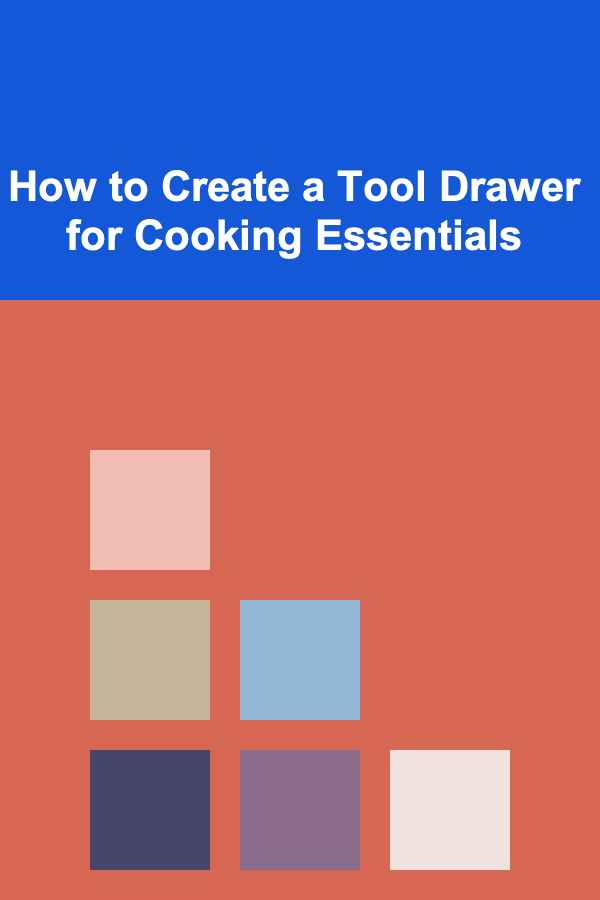
How to Create a Tool Drawer for Cooking Essentials
ebook include PDF & Audio bundle (Micro Guide)
$12.99$9.99
Limited Time Offer! Order within the next:

Creating an organized tool drawer for cooking essentials can significantly enhance your culinary experience. A well-designed drawer not only saves time during meal preparation but also keeps your kitchen tidy and makes it easier to maintain your cooking tools. This comprehensive guide will explore how to create a functional and efficient cooking tool drawer, covering everything from assessing your current setup to implementing creative solutions for long-term organization.
Understanding the Importance of an Organized Tool Drawer
1. Efficiency in Cooking
An organized tool drawer allows you to quickly locate and access the utensils you need, leading to faster meal prep and a smoother cooking process.
2. Enhanced Safety
Keeping sharp tools and utensils neatly stored reduces the risk of accidents. You know where everything is, which minimizes the chance of reaching for items blindly.
3. Improved Space Utilization
A well-organized drawer maximizes space in your kitchen. It prevents clutter, allowing for better use of available storage areas.
4. Promotes Mindfulness
An orderly environment encourages a more mindful approach to cooking. You can focus on the joy of preparing food rather than being distracted by disarray.
Assessing Your Current Cooking Tools
Step 1: Empty the Drawer
Begin by removing all items from your current tool drawer. This provides a clean slate and allows you to evaluate what you have.
Step 2: Categorize Your Tools
Group similar items together based on their functions, such as:
- Cutting Tools: Knives, peelers, scissors
- Measuring Tools: Measuring cups, spoons
- Cooking Utensils: Spatulas, tongs, ladles
- Baking Tools: Whisks, pastry brushes, rolling pins
- Miscellaneous Tools: Graters, can openers, timers
Step 3: Inspect Condition
Check each item for wear and tear. Discard anything that is broken, rusted, or no longer useful.
Step 4: Determine Frequency of Use
Identify which tools you use most often. Keep these items accessible, while less frequently used items can be stored further back.
Choosing the Right Drawer
1. Size Matters
Select a drawer that is wide and deep enough to accommodate your tools without overcrowding. Ensure there's enough vertical space to allow for dividers and organizers.
2. Location Considerations
Choose a drawer that is easily accessible while cooking. Ideally, it should be near your countertop and cooking appliances.
3. Drawer Type
Consider whether you want a traditional drawer, a pull-out cabinet, or even a cart with drawers if you lack sufficient cabinetry.
Essential Tools for Your Cooking Drawer
1. Knives
Invest in a good set of kitchen knives---chef's knife, paring knife, and serrated knife are essential.
2. Cutting Boards
Have at least one plastic and one wooden cutting board for different types of food prep.
3. Measuring Cups and Spoons
Include both dry and liquid measuring containers for accurate ingredient measurement.
4. Mixing Bowls
Use nesting mixing bowls that save space when not in use.
5. Spatulas and Tongs
Essential for flipping, stirring, and serving food without scratching non-stick surfaces.
6. Whisk
A sturdy whisk is crucial for blending ingredients smoothly.
7. Peeler and Grater
These tools enhance your food prep capabilities, making tasks like peeling fruits and grating cheese effortless.
8. Timers and Thermometers
Digital timers and cooking thermometers ensure your food is cooked perfectly every time.
Selecting Organizational Tools
1. Drawer Dividers
Adjustable or fixed dividers help keep items separated and easy to find. Choose materials that match the aesthetic of your kitchen.
2. Utensil Holders
These can be placed in the drawer to keep utensils upright and visible.
3. Baskets and Bins
Clear or labeled bins can group similar items, making it easy to grab what you need quickly.
4. Magnetic Strips
For metal utensils, consider installing magnetic strips inside the drawer or on the side of cabinets. This keeps them visible and easily accessible.
5. Labels
Labeling containers and sections helps everyone in the household know where things belong.
Steps to Organize Your Tool Drawer
Step 1: Clean the Drawer
Wipe down the inside of the drawer before placing items back. This ensures a sanitary environment.
Step 2: Install Dividers or Organizers
Place adjustable dividers into the drawer according to your measurements. Position them to create compartments for different categories of tools.
Step 3: Sort and Place Items
- Frequently Used Items: Place these at the front for easy access.
- Occasionally Used Items: Store these behind frequently used tools.
- Rarely Used Items: These can go towards the back or in separate bins.
Step 4: Use Containers Wisely
Group similar items in clear containers or baskets. For example, place all measuring tools in one bin and baking utensils in another.
Step 5: Label Everything
Use labels for each section or container. This could be as simple as writing on masking tape or using a label maker for a polished look.
Step 6: Close the Drawer and Test
Once everything is organized, close the drawer and open it again to ensure that items slide in and out smoothly.
Creative Solutions for Specific Needs
1. Deep Drawers
For deeper drawers, consider using tiered organizers or stacking bins to maximize vertical space.
2. Shallow Drawers
In shallow drawers, use flat, low-profile dividers to keep items separated without taking up too much space.
3. Small Kitchens
If space is limited, think about utilizing wall space for hanging utensils or using a rolling cart that can hold additional tools.
4. Portable Solutions
For those who love outdoor cooking, consider a portable organizer or caddy that can hold essentials for barbecues or picnics.
5. Children-Friendly Options
If kids help in the kitchen, designate a section of the drawer for child-friendly tools. Use bright colors or fun shapes to make it inviting.
Maintaining Your Tool Drawer
1. Regular Decluttering
Schedule regular check-ups, perhaps monthly or quarterly, to assess the contents of your drawer. Remove any items that are broken or unused.
2. Clean as You Go
Whenever you take an item out, make it a habit to return it in its designated spot immediately after use.
3. Adapt to New Purchases
As you acquire new cooking tools, reassess your organization system to find a proper home for them.
4. Educate Household Members
Teach everyone in the household about the organization system. Encourage them to put items back where they belong.
5. Seasonal Adjustments
If you have seasonal tools (like grilling tools in summer), consider rotating them in and out of the drawer to make space for everyday essentials.
Troubleshooting Common Issues
Problem 1: Overcrowding
Solution: If the drawer feels overcrowded, consider removing duplicates or donating items you rarely use. Regular decluttering can help avoid this issue.
Problem 2: Difficulty Finding Items
Solution: Reevaluate your organizational structure. Group similar items more distinctly and ensure that labels are clear and visible.
Problem 3: Items Getting Damaged
Solution: To prevent damage, store sharp utensils away from softer items and consider adding protective sleeves or padding between tools.
Problem 4: Drawer Not Closing Properly
Solution: Check that items aren't protruding beyond the edges of the drawer. Adjust dividers if necessary to ensure everything fits comfortably.
Problem 5: Broken or Worn-Out Tools
Solution: Periodically inspect your tools for signs of wear. Replace or repair items as needed to maintain functionality.
Conclusion
Creating a tool drawer for cooking essentials is an investment in both efficiency and enjoyment in the kitchen. By following the steps outlined in this guide, you can develop a system tailored to your needs, ensuring that every tool is easy to access and properly organized.
Start today by assessing your current setup, sorting your cooking tools, and implementing smart organizational strategies. With ongoing maintenance and adaptation, your tool drawer can remain a streamlined resource that enhances your cooking experience for years to come!
Reading More From Our Other Websites
- [Horseback Riding Tip 101] Gear Guide: Must-Have Equipment and Tack for Safe and Stylish Western Riding
- [Home Party Planning 101] Best Strategies for a Successful Home Party That Avoids Common Mistakes
- [Home Security 101] How to Ensure Your Home Security System Is Always Up-to-Date
- [Home Rental Property 101] How to Secure an Apartment for Rent with Assigned Parking
- [Home Family Activity 101] How to Start a Family Book Club with Your Kids
- [Rock Climbing Tip 101] Mastering the Double Dyno on Overhanging Limestone Routes
- [Stamp Making Tip 101] Eco-Friendly Stamp Making: Recycled Materials for Sustainable Kids' Art
- [Organization Tip 101] How to Use Technology to Help Manage Clutter
- [Home Lighting 101] How to Choose the Right Lighting for Makeup Application
- [Home Family Activity 101] How to Build a Family Tree Together and Learn About Heritage

Earn Money by Developing and Selling Pre-Trained Deep Learning Models
Read More
How to Create a Holiday-Themed Kids' Room with Fun and Functional Decor
Read More
How to Create a Master Document List for Your Home or Office
Read More
How to Understand Proofing Bread
Read More
How to Develop Black and White Film at Home
Read More
How to Build a Voice Over Demo Reel That Gets You Hired
Read MoreOther Products

Earn Money by Developing and Selling Pre-Trained Deep Learning Models
Read More
How to Create a Holiday-Themed Kids' Room with Fun and Functional Decor
Read More
How to Create a Master Document List for Your Home or Office
Read More
How to Understand Proofing Bread
Read More
How to Develop Black and White Film at Home
Read More